-
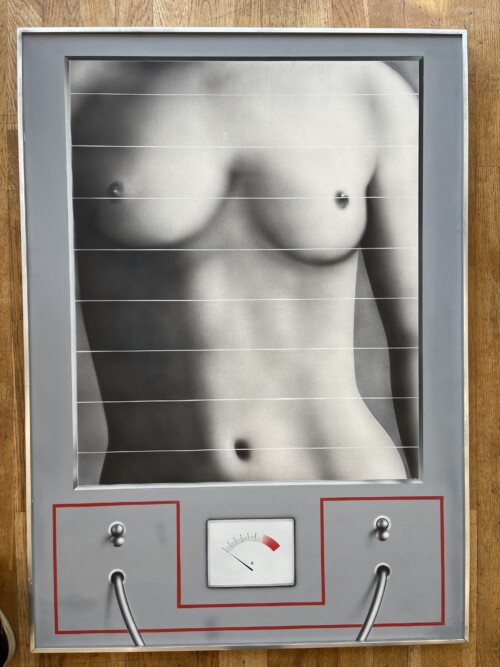
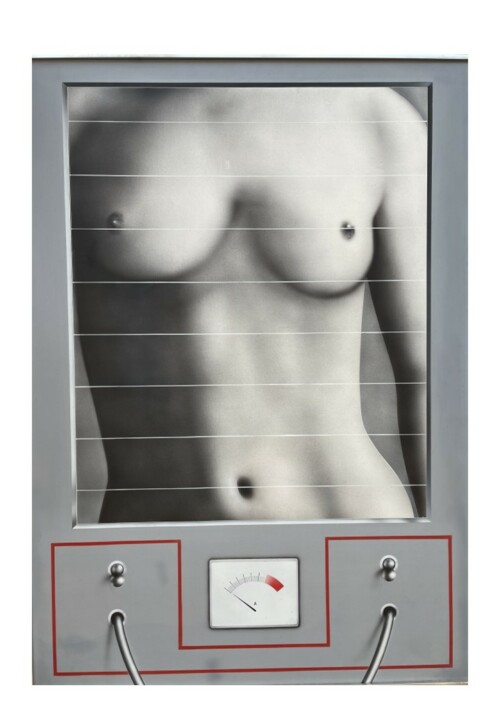 KLASEN Peter (né en 1935), “Expérience I”, 1972, acrylique sur carton, signé, daté, titré au dos. Exceptionnelle peinture réalisée par Peter Klasen en 1972. Peter Klasen est un artiste allemand, installé à Paris en 1959 rejoignant l’avant-garde internationale parisienne et fuyant cette Allemagne déchirée et ruinée d’après-guerre. Il fait partie de ces artistes des années 1960 qui renouvellent la peinture figurative en opposition à l’abstraction. Ses œuvres, reconnaissables par un usage de l’aérographe, sont composées de corps, souvent féminins, mêlés à des objets sanitaires, machiniques, utilitaires. Ses œuvres traitent de sa vision d’une société transformée par la modernité, des conflits de la vie moderne, des villes traumatisantes, aliénantes. Cette œuvre est exceptionnelle car c’est une œuvre de la meilleure et plus intéressante période de l’artiste (années 1960-1970). Les œuvres de cette période sont caractérisées par un usage du gris, blanc et noir ; elles sont les plus recherchées. L’œuvre est vendue avec un certificat délivré par l’artiste le 14 septembre 1982. Elle est signée, datée et titrée au dos et provient de la prestigieuse collection Jean-Pierre et Martine Nuand. H : 105 cm L : 75 cm Biographie : LASCAULT, Peter Klasen, Ides et Calendes, Neuchâtel, 2005 LE THOREL, Peter Klasen et la photographie : l'investigation du réel, Actes Sud, Arles, 2010 TILMAN, Peter Klasen, éd. Galilée, Paris, 1979 ---------------------------------------------------------------- Stunning painting by Peter Klasen (born in 1935), “Expérience I”, 1972, Acrylic on cardboard. Peter Klasen is a German artist settled in Paris in 1959. He joined the international Avant-Garde in Paris, fleeing post-war defeated and divided Germany. He is among the artists who renew figurative painting in opposition to abstraction. His paintings are recognizable by the use of an airbrush. His artworks are representing female bodies intertwined with sanitary, machinist and utilitarian objects. He depicts his vision of a society changed by modernity, the conflicts of this modern life, and the traumatizing cities. This painting belongs to his most sought after production period (1960-1970’s). His works from this period are characterized by the use of black, gray and white. The artwork is sold with a certificate written by the artist on the 14th of September 1982, and comes from the famous Jean-Pierre and Martine Nuand collection. It is signed, titled and dated on the back. H : 105 cm/41.34 inches L : 75 cm/29.53 inches Biography : LASCAULT, Peter Klasen, Ides et Calendes, Neuchâtel, 2005 LE THOREL, Peter Klasen et la photographie : l'investigation du réel, Actes Sud, Arles, 2010 TILMAN, Peter Klasen, éd. Galilée, Paris, 1979
KLASEN Peter (né en 1935), “Expérience I”, 1972, acrylique sur carton, signé, daté, titré au dos. Exceptionnelle peinture réalisée par Peter Klasen en 1972. Peter Klasen est un artiste allemand, installé à Paris en 1959 rejoignant l’avant-garde internationale parisienne et fuyant cette Allemagne déchirée et ruinée d’après-guerre. Il fait partie de ces artistes des années 1960 qui renouvellent la peinture figurative en opposition à l’abstraction. Ses œuvres, reconnaissables par un usage de l’aérographe, sont composées de corps, souvent féminins, mêlés à des objets sanitaires, machiniques, utilitaires. Ses œuvres traitent de sa vision d’une société transformée par la modernité, des conflits de la vie moderne, des villes traumatisantes, aliénantes. Cette œuvre est exceptionnelle car c’est une œuvre de la meilleure et plus intéressante période de l’artiste (années 1960-1970). Les œuvres de cette période sont caractérisées par un usage du gris, blanc et noir ; elles sont les plus recherchées. L’œuvre est vendue avec un certificat délivré par l’artiste le 14 septembre 1982. Elle est signée, datée et titrée au dos et provient de la prestigieuse collection Jean-Pierre et Martine Nuand. H : 105 cm L : 75 cm Biographie : LASCAULT, Peter Klasen, Ides et Calendes, Neuchâtel, 2005 LE THOREL, Peter Klasen et la photographie : l'investigation du réel, Actes Sud, Arles, 2010 TILMAN, Peter Klasen, éd. Galilée, Paris, 1979 ---------------------------------------------------------------- Stunning painting by Peter Klasen (born in 1935), “Expérience I”, 1972, Acrylic on cardboard. Peter Klasen is a German artist settled in Paris in 1959. He joined the international Avant-Garde in Paris, fleeing post-war defeated and divided Germany. He is among the artists who renew figurative painting in opposition to abstraction. His paintings are recognizable by the use of an airbrush. His artworks are representing female bodies intertwined with sanitary, machinist and utilitarian objects. He depicts his vision of a society changed by modernity, the conflicts of this modern life, and the traumatizing cities. This painting belongs to his most sought after production period (1960-1970’s). His works from this period are characterized by the use of black, gray and white. The artwork is sold with a certificate written by the artist on the 14th of September 1982, and comes from the famous Jean-Pierre and Martine Nuand collection. It is signed, titled and dated on the back. H : 105 cm/41.34 inches L : 75 cm/29.53 inches Biography : LASCAULT, Peter Klasen, Ides et Calendes, Neuchâtel, 2005 LE THOREL, Peter Klasen et la photographie : l'investigation du réel, Actes Sud, Arles, 2010 TILMAN, Peter Klasen, éd. Galilée, Paris, 1979 -
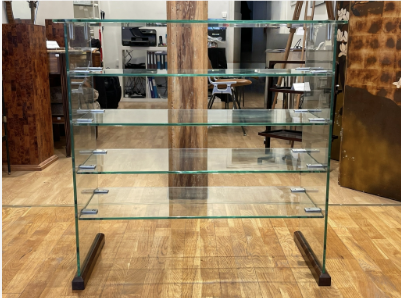
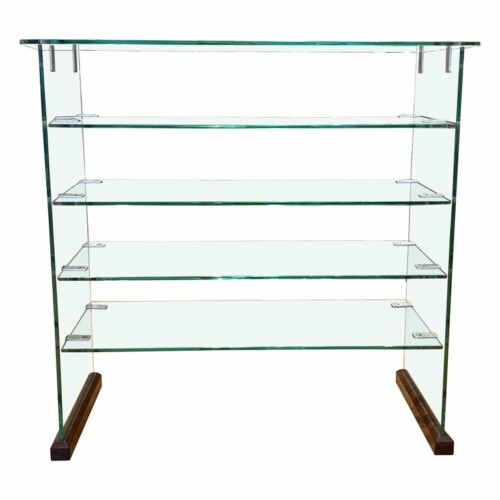 GIO PONTI, Etagère en laiton et verre, Circa 1939 Elégante étagère de laiton et de verre, comportant cinq étagères soutenues de bois maintenues par deux lames de verres aux extrémités, le tout solidement relié et fixé par des vis en laiton. Le verre est engravé « Vitrex » Réalisé à l’origine pour les bureaux de la société Ventrocoke à Milan Gio Ponti est diplômé de l’Ecole Polytechnique de Milan, et ouvre en 1921 son cabinet d’architecture. Il est nommé directeur artistique de la manufacture de porcelaine Richard-Ginori en 1923. En 1925,il remporte un grand prix à l’Exposition internationale des Arts Décoratifs de Paris. Il collabore également avec les marques Christofle à Paris et Venini à Murano. En parallèle, il crééé galement des séries de meubles Art Deco à des prix accessibles , La Rinascente, pour les grands magasins italiens un choix. S’ajoute à cela sa revue Domus fondée en 1928 dans laquelle il mettra en avant le « made in italy ». Dans les années 1930, il entame la construction des Case Tipiche, à Milan, et des bureaux pour la société Montecatini. En 1940, il se consacre au Palazzo del Bo de l’université de Padoue. Pour finir de 1950 à 1960, Gio Ponti sera surtout connu pour son architecture qu’il déployera à travers le monde Dimensions : H : 84 cm L : 88 cm P : 37 cm
GIO PONTI, Etagère en laiton et verre, Circa 1939 Elégante étagère de laiton et de verre, comportant cinq étagères soutenues de bois maintenues par deux lames de verres aux extrémités, le tout solidement relié et fixé par des vis en laiton. Le verre est engravé « Vitrex » Réalisé à l’origine pour les bureaux de la société Ventrocoke à Milan Gio Ponti est diplômé de l’Ecole Polytechnique de Milan, et ouvre en 1921 son cabinet d’architecture. Il est nommé directeur artistique de la manufacture de porcelaine Richard-Ginori en 1923. En 1925,il remporte un grand prix à l’Exposition internationale des Arts Décoratifs de Paris. Il collabore également avec les marques Christofle à Paris et Venini à Murano. En parallèle, il crééé galement des séries de meubles Art Deco à des prix accessibles , La Rinascente, pour les grands magasins italiens un choix. S’ajoute à cela sa revue Domus fondée en 1928 dans laquelle il mettra en avant le « made in italy ». Dans les années 1930, il entame la construction des Case Tipiche, à Milan, et des bureaux pour la société Montecatini. En 1940, il se consacre au Palazzo del Bo de l’université de Padoue. Pour finir de 1950 à 1960, Gio Ponti sera surtout connu pour son architecture qu’il déployera à travers le monde Dimensions : H : 84 cm L : 88 cm P : 37 cm
GIO PONTI, Brass and glass shelf, Circa 1939 Elegant brass and glass shelf, featuring five supported wooden shelves held by two glass blades at the ends, all securely connected and fixed by brass screws. The glass is engraved «Vitrex» Originally designed for the Ventrocoke offices in Milan Gio Ponti graduated from the Polytechnic of Milan, and opened his architectural practice in 1921. He was appointed artistic director of the Richard-Ginori porcelain factory in 1923. In 1925, he won a grand prize at the International Exhibition of Decorative Arts in Paris. He also collaborates with the brands Christofle in Paris and Venini in Murano. In parallel, he also created series of Art Deco furniture at affordable prices , La Rinascente, for Italian department stores a choice. In addition to this, his magazine Domus, founded in 1928, will highlight the «made in italy». In the 1930s, he began the construction of the Case Tipiche in Milan and offices for the company Montecatini. In 1940 he dedicated himself to the Palazzo del Bo of the University of Padua. To finish from 1950 to 1960, Gio Ponti will be best known for his architecture that he will deploy around the world Dimensions: H: 33.1inches W: 34.5inches D: 14.5inches -
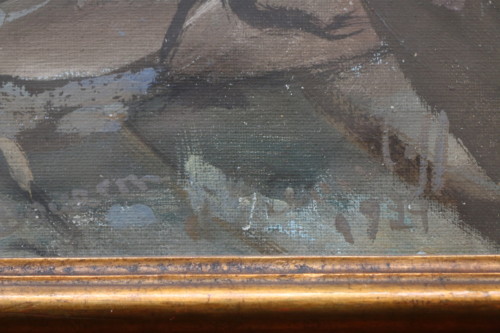
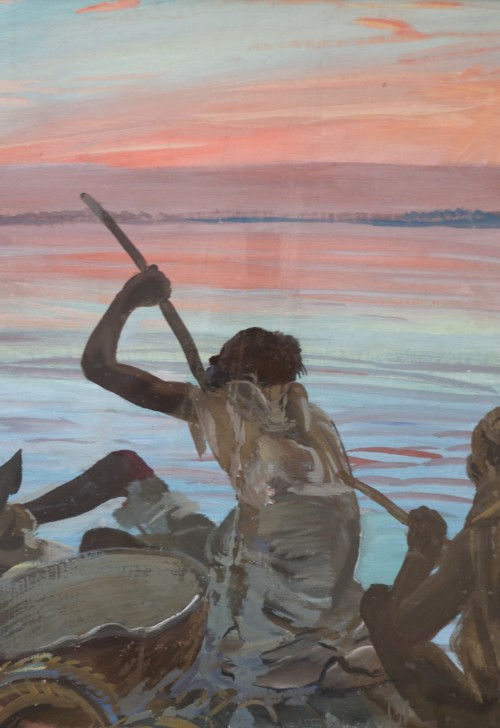 Alexander IAKOVLEV (1887-1938) La Pirogue Technique mixte sur toile sur carton Peinte durant la Croisière Noire, à Bourem village malien sur le fleuve Niger Signée et datée 1927 Dimensions : H : 64 cm ; L : 46 cm Certificat d'Elena Iacovleva spécialiste de Iakovlev Pour plus d'informations sur le créateur, cliquer sur son nom : Alexander Iakovlev
Alexander IAKOVLEV (1887-1938) La Pirogue Technique mixte sur toile sur carton Peinte durant la Croisière Noire, à Bourem village malien sur le fleuve Niger Signée et datée 1927 Dimensions : H : 64 cm ; L : 46 cm Certificat d'Elena Iacovleva spécialiste de Iakovlev Pour plus d'informations sur le créateur, cliquer sur son nom : Alexander Iakovlev
Oil on canvas "The Pirogue" by Alexander Iakovlev (1887-1938) Mixed canvas technique on carboard Painting during the Black Cruise, in Bourem a malian village on the Noger river Signed and dated of the year 27 Dimensions : H : 25.5 in ; W : 25.5 in H : 64 cm ; W : 18.12 cm For more information : Alexander Iakovlev